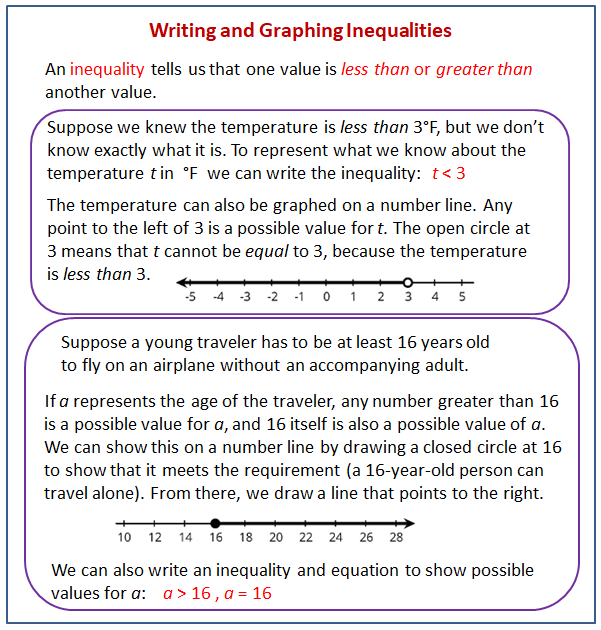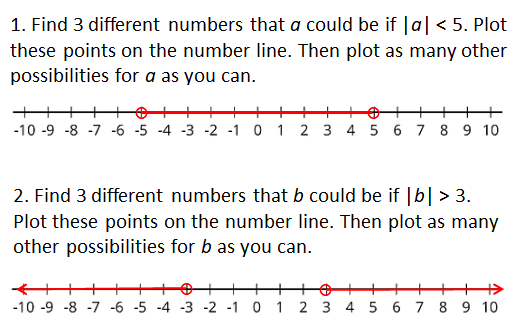Illustrative Mathematics Unit 6.7, Lesson 8: Writing and Graphing Inequalities
Learning Targets:
- I can graph inequalities on a number line.
- I can write an inequality to represent a situation.
Related Pages
Illustrative Math
Grade 6
Lesson 8: Writing and Graphing Inequalities
Let’s write inequalities.
Illustrative Math Unit 6.7, Lesson 8 (printable worksheets)
Lesson 8 Summary
The following diagram shows some examples of how to write and graph inequalities.

Lesson 8.1 Estimate Heights of People
- Here is a picture of a man.
a. Name a number, in feet, that is clearly too high for this man’s height.
b. Name a number, in feet, that is clearly too low for his height.
c. Make an estimate of his height.
Pause here for a class discussion. - Here is a picture of the same man standing next to a child.
If the man’s actual height is 5 feet 10 inches, what can you say about the height of the child in this picture? Be prepared to explain your reasoning.
Scroll down the page for the solutions to the “Are you ready for more?” section.
Lesson 8.2 Stories about 9
Drag the green and red open points over the blue points, matching each story, graph, and description.
Open Applet
- Record your results with a number followed by a capital letter and a lowercase letter. For example, 1Aa would mean that responses “1”, “A”, and “a” all represent the same situation.
- Think about how you would represent each set of numbers with an inequality statement, talk about it with your partner, and be prepared to discuss your ideas with the class.
- Record your final matching decisions like this:
a. A fishing boat can hold fewer than 9 people. How many people (x) can it hold?
- Description or list:
- Number line:
- Inequality: b. Lin needs more than 9 ounces of butter to make cookies for her party. How many ounces of butter (x) would be enough?
- Description or list:
- Number line:
- Inequality: b. A magician will perform her magic tricks only if there are at least 9 people in the audience. For how many people (x) will she perform her magic tricks?
- Description or list:
- Number line:
- Inequality: c. A food scale can measure up to 9 kilograms of weight. What weights () can the scale measure?
- Description or list:
- Number line:
- Inequality:
Lesson 8.3 How High and How Low Can It Be?
Here is a picture of a person and a basketball hoop. Based on the picture, what do you think are reasonable estimates for the maximum and minimum heights of the basketball hoop?
- Complete the first blank in each sentence with an estimate, and the second blank with “taller” or “shorter.”
a. I estimate the minimum height of the basketball hoop to be _________ feet; this means the hoop cannot be _____________ than this height.
b. I estimate the maximum height of the basketball hoop to be _________ feet; this means the hoop cannot be _____________ than this height. - Write two inequalities—one to show your estimate for the minimum height of the basketball hoop, and another for the maximum height. Use an inequality symbol and the variable to represent the unknown height.
- Plot each estimate for minimum or maximum value on a number line.
- Suppose a classmate estimated the value of h to be 19 feet. Does this estimate agree with your inequality for the maximum height? Does it agree with your inequality for the minimum height? Explain or show how you know.
- Ask a partner for an estimate of h. Record the estimate and check if it agrees with your inequalities for maximum and minimum heights.
Are you ready for more?
- Find 3 different numbers that a could be if |a| < 5. Plot these points on the number line. Then plot as many other possibilities for a as you can.
- Find 3 different numbers that b could be if |b| > 3. Plot these points on the number line. Then plot as many other possibilities for b as you can.
Lesson 8 Practice Problems
- At the book sale, all books cost less than $5.
a. What is the most expensive a book could be?
b. Write an inequality to represent costs of books at the sale.
c. Draw a number line to represent the inequality. - Kiran started his homework before 7:00 p.m. and finished his homework after 8:00 p.m. Let represent the number of hours Kiran worked on his homework.
Decide if each statement it is definitely true, definitely not true, or possibly true. Explain your reasoning.
a. h > 1
b. h > 2
c. h < 1
d. h < 2 - Consider a rectangular prism with length 4 and width and height d.
a. Find an expression for the volume of the prism in terms of d.
b. Compute the volume of the prism when d = 1, when d = 2, and when d = 1/2. - Match the mathematical statements with the statements written in English. All of these statements are true.
- Here are five sums. Use the distributive property to write each sum as a product with two factors.
a. 2a + 7a
b. 5z - 10
c. c - 2c2
d. r + r + r + r
e. 2x - 1/2
The Open Up Resources math curriculum is free to download from the Open Up Resources website and is also available from Illustrative Mathematics.
Try the free Mathway calculator and
problem solver below to practice various math topics. Try the given examples, or type in your own
problem and check your answer with the step-by-step explanations.

We welcome your feedback, comments and questions about this site or page. Please submit your feedback or enquiries via our Feedback page.
